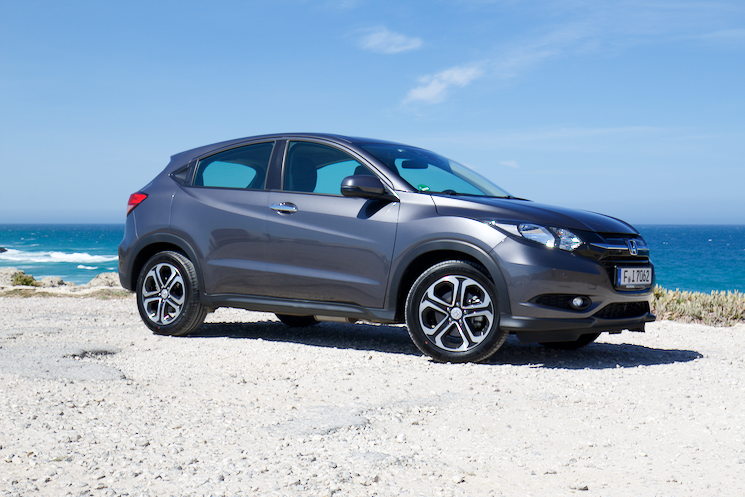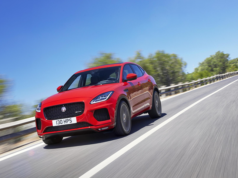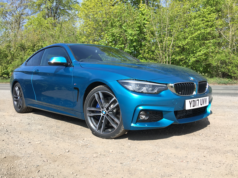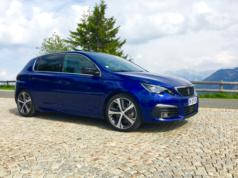The phrase ‘good things come in small packages’ is used in many different contexts, but does it hold true with a car? Honda have attempted to prove this is the case with the new Honda HR-V as the crossover has been reborn to fight in one of the most fiercely competitive automotive markets. The crossover segment is growing at the highest rate of any market at 11% in the UK, so Honda are undertaking a huge task by re-entering the segment which is dominated by the Nissan Qashqai. The question is, do they stand a chance?
The styling of the new HR-V makes a promising start. Honda describe it as when the personal feel of a coupe, meets the usability of an MPV with the strength of an SUV. The HR-V certainly does show an essence of coupe styling – thanks to the hidden rear door handles in the C-pillar and the sloping roof line. The sharp lines down the side to the nose give the HR-V a more dynamic feel as well. Bold 16 inch or 17 inch alloy wheels finish off what is a very good looking car. There is a wide range of colours to choose from as well: pearlescent white orchid, crystal black, morpho blue, solid Milano red, metallic albaster silver, brilliant sporty blue, ruse black and modern steel.
This slick design continues on to the interior. When sat high up in the supportive seats you are met by an ergonomic cockpit. The Honda CONNECT infotainment system, which is an option on the base S specification and standard across the rest of the range, is very intuitive and easy to use with a host of functions such as internet radio, Aha app integration and internet browsing. Below the 7 inch touch screen is the touch sensitive climate control system which is once again easy to use and adds to the premium feel of the HR-V. The top level EX spec boasts more luxuries such as heated seats, smart entry & start and a panoramic open glass roof which expands what is already a well sized cabin and adds an increased sense of opulence. Honda are also claiming a ‘class leading’ level of space for this segment – the boot has 470 litres of space with the seats up and 1,533 litres with the seats flat – making it larger than the Nissan Qashqai and falling marginally short of the new Renault Kadjar. All models of the HR-V come with Honda’s Magic seats configuration which can prove very useful for taller items. The rear seats are also effortless to fold flat. Folding all seats down in the HR-V means it can cater for almost any day-to-day item you will want to move. The only issue with space is that the centre rear seat isn’t quite adequate for adults and may become uncomfortable on long journeys with three in the back due to the coupe-style sloping roof line.
From launch the HR-V will be available with either a 1.6 litre i-DTEC Diesel engine coupled to a six-speed manual transmission or a 1.5 litre i-VTEC petrol engine which comes with either a six-speed manual transmission or an automatic CVT gearbox. The diesel engine, which we have seen in the likes of the Honda Civic, produces 120 PS and 300 Nm of torque which kicks in at around 2000 rpm and does pull away very well. 0-62mph is done in 10.0 seconds in the S Spec, 10.2 seconds in the SE and SE Navi and 10.5 seconds in the EX model with a top speed of 119 mph. The i-DTEC also returns very impressive economy – with a combined figure of 70.6 mpg in the S and 68.9 mpg for the other specifications. It is also a smooth and quiet engine which makes for a more relaxed drive. The petrol engine produces 130 PS and 155 Nm of torque, meaning 0-62 mph takes 10.4 seconds in the SE spec with the manual transmission and 10.9 seconds with the CVT gearbox. The petrol engine is louder than the diesel which is noticeable, particularly driving at high speeds on the motorway. Combined efficiency is 49.6 mpg and 52.3 mpg in the manual and CVT gearbox respectively in the petrol model. When driving through hilly or mountainous terrain the petrol engine does feel a bit underpowered and you’ll have to work the gearbox to keep momentum. In other areas such as city environments the petrol engine is still a good option, however. Almost double the torque in the diesel engine means it performs much better on gradients. It is also smoother on the motorway and overtaking is dealt with much more efficiently with the diesel engine.
The new Honda HR-V also handles well for this type of car – the steering is slightly more weighted than in other Honda models such as the CR-V which gives it increased feel when tackling the bends. Although it is still light, it is an improvement over other models. There is also plenty of grip on offer and you can take on corners quickly with confidence. The ride is also pleasing, the suspension soaks up the bumps well and is very comfortable on these European roads. Our full road test back on our rough British tarmac will reveal all. There is also very little wind noise due to the aerodynamic shape of the car and there is also an absence of any really noticeable road noise despite the larger alloy wheels. This makes the HR-V an ideal tool for long journeys.
There’s also a host of safety tech available. Anti-lock brakes, brake assist, hill start assist and the city brake active system comes as standard across the range. Any model above the base S specification also comes with forward collision warning, lane departure warning, traffic sign recognition as well as a new feature on the speed limiter which will adjust the maximum limit using the traffic sign recognition system. This system is similar to Ford’s Intelligent Speed Limiter. A new auto brake hold feature is also available, a button located on the centre console enables the driver to take their foot off the brake, this function disengages upon acceleration. This was particularly useful when waiting at junctions on a slight incline, for example.
There are four trim levels available on the HR-V: S, SE, SE Navi and EX. On the road prices start from £17,995 for the 1.5 i-VTEC S model and stop at £24,945 for the 1.6-iDTEC EX. PCP is also available across the range with an initial deposit of 10%, 20% or 30% with 36 payments from between £149 – £309, making the new HR-V very affordable.
It seems then that good things do indeed come in small packages. A coupe style profile with a cleverly designed interior allows for a lot of space inside. One of the most generously sized boots in the segment as well as features such as magic seats and being able to fold the front passenger seat completely flat means the HR-V can swallow up pretty much anything you want to put in it. It is a comfortable and a reasonably fun car to drive. HR-V is very diverse in it’s capabilities. The diesel engine would be the one to go for due to the better performance and superior economy figures over the petrol as well as a smoother and quieter ride. If your heart is set on the petrol engine, then I would go for the manual gear box over the automatic CVT transmission to get the most out of the engine. Trim level comes down to personal preference. Honda equip their cars very well from base spec and so the S level wouldn’t be a bad choice to go for. The SE does add all the safety features as well as Honda CONNECT primarily and SE Navi adds the Garmin navigation system. The top spec EX model introduces smart entry & start, the panoramic roof, heated seats and a rear view camera mainly. Unless you see these luxuries as a necessity it may be worth saving your hard earned pounds. The Honda HR-V i-DTEC SE costs £21,495 or a 20% deposit with 36 payments of £259. Adding the Garmin navigation ups the price to £22,105 or £279 payments after a 20% deposit. EX ups the price to £24,945 or £309 with a 20% deposit.
Honda have reentered this market in full force and have created a real contender for this segment. Whilst it is too early to say whether it will dethrone the Qashqai, it certainly does have a chance.











